Facile and Low-Cost SPE Modification Towards Ultra-Sensitive Organophosphorus and Carbamate Pesticide Detection in Olive Oil
Abstract
1. Introduction
2. Results and Discussion
2.1. Choice of Substrate
2.2. Optimization of Biosensor Fabrication
2.3. Measurement of Pesticide Inhibition of AChE in Standard Samples in Buffer
2.4. Improving on Surface Functionalization Reproducibility
2.5. Measurements in Spiked Olive Oil Samples
3. Materials and Methods
3.1. Materials
3.2. Apparatus
3.3. Electrode Functionalization with CB and fCB
3.4. SPE Characterization with Enzymatically-Produced Thiocholine
3.5. Fabrication of the Biosensor
3.6. Measurement of AChE Inhibition by Chlorpyrifos and Carbofuran
3.7. Laser Induced Forward Transfer (LIFT) Technique for SPEs Surface Modification
3.8. Real Sample Analysis
4. Conclusions
Supplementary Materials
Author Contributions
Funding
Acknowledgments
Conflicts of Interest
References
- EC. EU Agricultural Outlook for Markets and Income, 2019–2030; European Commission, DG Agriculture and Rural Development: Brussels, Belgium, 2019; ISBN 9789276153818. [Google Scholar]
- Verma, N.; Bhardwaj, A. Biosensor Technology for Pesticides—A review. Appl. Biochem. Biotechnol. 2015, 175, 3093–3119. [Google Scholar] [CrossRef] [PubMed]
- Ferrer, C.; Gómez, M.J.; Garcia-Reyes, J.F.; Ferrer, I.; Thurman, E.M.; Fernández-Alba, A.R. Determination of pesticide residues in olives and olive oil by matrix solid-phase dispersion followed by gas chromatography/mass spectrometry and liquid chromatography/tandem mass spectrometry. J. Chromatogr. A 2005, 1069, 183–194. [Google Scholar] [CrossRef] [PubMed]
- Pérez-Fernández, B.; Mercader, J.V.; Checa-Orrego, B.I.; De La Escosura-Muñiz, A.; Costa-García, A. A monoclonal antibody-based immunosensor for the electrochemical detection of imidacloprid pesticide. Analyst 2019, 144, 2936–2941. [Google Scholar] [CrossRef]
- Reynoso, E.C.; Torres, E.; Bettazzi, F.; Palchetti, I. Trends and Perspectives in Immunosensors for Determination of Currently-Used Pesticides: The Case of Glyphosate, Organophosphates, and Neonicotinoids. Biosensors 2019, 9, 20. [Google Scholar] [CrossRef] [PubMed]
- Liu, M.; Khan, A.; Wang, Z.; Liu, Y.; Yang, G.; Deng, Y.; He, N. Aptasensors for pesticide detection. Biosens. Bioelectron. 2019, 130, 174–184. [Google Scholar] [CrossRef]
- Sroysee, W.; Chunta, S.; Amatatongchai, M.; Lieberzeit, P.A. Molecularly imprinted polymers to detect profenofos and carbofuran selectively with QCM sensors. Phys. Med. 2019, 7, 100016. [Google Scholar] [CrossRef]
- Khalifa, M.E.; Abdallah, A. Molecular imprinted polymer based sensor for recognition and determination of profenofos organophosphorous insecticide. Biosens. Bioelectron. X 2019, 2, 100027. [Google Scholar] [CrossRef]
- Capoferri, D.; Della Pelle, F.; Del Carlo, M.; Compagnone, D. Affinity Sensing Strategies for the Detection of Pesticides in Food. Foods 2018, 7, 148. [Google Scholar] [CrossRef]
- Songa, E.A.; Okonkwo, J.O. Recent approaches to improving selectivity and sensitivity of enzyme-based biosensors for organophosphorus pesticides: A review. Talanta 2016, 155, 289–304. [Google Scholar] [CrossRef]
- Montes, R.; Céspedes, F.; Gabriel, D.; Baeza, M. Electrochemical Biosensor Based on Optimized Biocomposite for Organophosphorus and Carbamates Pesticides Detection. J. Nanomater. 2018, 2018, 1–13. [Google Scholar] [CrossRef]
- Da Silva, M.K.; Vanzela, H.C.; DeFavari, L.M.; Cesarino, I. Determination of carbamate pesticide in food using a biosensor based on reduced graphene oxide and acetylcholinesterase enzyme. Sensors Actuators B Chem. 2018, 277, 555–561. [Google Scholar] [CrossRef]
- Gursoy, O.; Gursoy, S.S.; Cogal, S.; Cogal, G.C. Development of a new two-enzyme biosensor based on poly(pyrrole-co-3,4-ethylenedioxythiophene) for lactose determination in milk. Polym. Eng. Sci. 2017, 58, 839–848. [Google Scholar] [CrossRef]
- Arduini, F.; Forchielli, M.; Scognamiglio, V.; Nikolaevna, K.A.; Moscone, D. Organophosphorous Pesticide Detection in Olive Oil by Using a Miniaturized, Easy-to-Use, and Cost-Effective Biosensor Combined with QuEChERS for Sample Clean-Up. Sensors 2016, 17, 34. [Google Scholar] [CrossRef] [PubMed]
- Vale, A.; Lotti, M. Organophosphorus and carbamate insecticide poisoning. In Handbook of Clinical Neurology; Elsevier BV: Amsterdam, The Netherlands, 2015; Volume 131, pp. 149–168. [Google Scholar]
- Arduini, F.; Cinti, S.; Mazzaracchio, V.; Scognamiglio, V.; Amine, A.; Moscone, D. Carbon black as an outstanding and affordable nanomaterial for electrochemical (bio)sensor design. Biosens. Bioelectron. 2020, 156, 112033. [Google Scholar] [CrossRef]
- Arslan, F.; Beskan, U. An amperometric biosensor for glucose detection from glucose oxidase immobilized in polyaniline–polyvinylsulfonate–potassium ferricyanide film. Artif. Cells Nanomed. Biotechnol. 2014, 42, 284–288. [Google Scholar] [CrossRef]
- Abbas, M.; Saeed, A.A.M.; Ben Ali, M.; Errachid, A.; Zine, N.; Baraket, A.; Singh, B. Biosensor for the oxidative stress biomarker glutathione based on SAM of cobalt phthalocyanine on a thioctic acid modified gold electrode. J. Solid State Electrochem. 2019, 23, 1129–1144. [Google Scholar] [CrossRef]
- Pundir, C.; Chauhan, N. Acetylcholinesterase inhibition-based biosensors for pesticide determination: A review. Anal. Biochem. 2012, 429, 19–31. [Google Scholar] [CrossRef]
- Karyakin, A.A. Advances of Prussian blue and its analogues in (bio)sensors. Curr. Opin. Electrochem. 2017, 5, 92–98. [Google Scholar] [CrossRef]
- Gupta, S.; Murthy, C.; Prabha, C.R. Recent advances in carbon nanotube based electrochemical biosensors. Int. J. Biol. Macromol. 2018, 108, 687–703. [Google Scholar] [CrossRef]
- Rajangam, B.; Daniel, D.K.; Krastanov, A. Progress in enzyme inhibition based detection of pesticides. Eng. Life Sci. 2018, 18, 4–19. [Google Scholar] [CrossRef]
- Liu, G.; Riechers, S.L.; Mellen, M.C.; Lin, Y. Sensitive electrochemical detection of enzymatically generated thiocholine at carbon nanotube modified glassy carbon electrode. Electrochem. Commun. 2005, 7, 1163–1169. [Google Scholar] [CrossRef]
- Sun, X.; Wang, X. Acetylcholinesterase biosensor based on prussian blue-modified electrode for detecting organophosphorous pesticides. Biosens. Bioelectron. 2010, 25, 2611–2614. [Google Scholar] [CrossRef]
- Zhou, Q.; Yang, L.; Wang, G.; Yang, Y. Acetylcholinesterase biosensor based on SnO2 nanoparticles–carboxylic graphene–nafion modified electrode for detection of pesticides. Biosens. Bioelectron. 2013, 49, 25–31. [Google Scholar] [CrossRef] [PubMed]
- Arduini, F.; Amine, A.; Majorani, C.; Di Giorgio, F.; De Felicis, D.; Cataldo, F.; Moscone, D.; Palleschi, G. High performance electrochemical sensor based on modified screen-printed electrodes with cost-effective dispersion of nanostructured carbon black. Electrochem. Commun. 2010, 12, 346–350. [Google Scholar] [CrossRef]
- Pérez-Fernández, B.; Costa-García, A.; De La Escosura-Muñiz, A. Electrochemical (Bio)Sensors for Pesticides Detection Using Screen-Printed Electrodes. Biosensors 2020, 10, 32. [Google Scholar] [CrossRef]
- Long, C.M.; Nascarella, M.A.; Valberg, P.A. Carbon black vs. black carbon and other airborne materials containing elemental carbon: Physical and chemical distinctions. Environ. Pollut. 2013, 181, 271–286. [Google Scholar] [CrossRef] [PubMed]
- Donnet, J.-B.; Bansal, R.C.; Wang, M.-J. Carbon Black: Science and Technology, 2nd ed., rev.expanded.; Dekker: New York, NY, USA, 1993; ISBN 9780824789756. [Google Scholar]
- Evtugyn, G.; Hianik, T. Electroanalytical Bioplatforms Based on Carbon Nanostructures as New Tools for Diagnosis. In Nanotechnology and Biosensors; Elsevier BV: Amsterdam, The Netherlands, 2018; pp. 269–306. [Google Scholar]
- Silva, T.A.; Moraes, F.C.; Janegitz, B.C.; Fatibello-Filho, O. Electrochemical Biosensors Based on Nanostructured Carbon Black: A Review. J. Nanomater. 2017, 2017, 1–14. [Google Scholar] [CrossRef]
- Bucur, M.P.; Bucur, B.; Radu, G.-L. Critical Evaluation of Acetylthiocholine Iodide and Acetylthiocholine Chloride as Substrates for Amperometric Biosensors Based on Acetylcholinesterase. Sensors 2013, 13, 1603–1613. [Google Scholar] [CrossRef]
- Sassolas, A.; Blum, L.J.; Leca-Bouvier, B.D. Immobilization strategies to develop enzymatic biosensors. Biotechnol. Adv. 2012, 30, 489–511. [Google Scholar] [CrossRef]
- Samsidar, A.; Siddiquee, S. Acetylcholinesterase (AChE) Biosensors for Determination of Carbamate Pesticides. In Nanotechnology: Applications in Energy, Drug and Food; Springer Science and Business Media LLC: Berlin/Heidelberg, Germany, 2018; pp. 361–375. [Google Scholar]
- Zhang, P.; Sun, T.; Rong, S.; Zeng, D.; Chang, D.; Pan, H. A sensitive amperometric AChE-biosensor for organophosphate pesticides detection based on conjugated polymer and Ag-rGO-NH2 nanocomposite. Bioelectrochemistry 2019, 127, 163–170. [Google Scholar] [CrossRef]
- Talarico, D.; Arduini, F.; Amine, A.; Cacciotti, I.; Moscone, D.; Palleschi, G. Screen-printed electrode modified with carbon black and chitosan: A novel platform for acetylcholinesterase biosensor development. Anal. Bioanal. Chem. 2016, 408, 7299–7309. [Google Scholar] [CrossRef]
- Viswanathan, S.; Radecka, H.; Radecki, J. Electrochemical biosensor for pesticides based on acetylcholinesterase immobilized on polyaniline deposited on vertically assembled carbon nanotubes wrapped with ssDNA. Biosens. Bioelectron. 2009, 24, 2772–2777. [Google Scholar] [CrossRef]
- Chauhan, N.; Narang, J.; Pundir, C. Immobilization of rat brain acetylcholinesterase on ZnS and poly(indole-5-carboxylic acid) modified Au electrode for detection of organophosphorus insecticides. Biosens. Bioelectron. 2011, 29, 82–88. [Google Scholar] [CrossRef] [PubMed]
- Arduini, F.; Guidone, S.; Amine, A.; Palleschi, G.; Moscone, D. Acetylcholinesterase biosensor based on self-assembled monolayer-modified gold-screen printed electrodes for organophosphorus insecticide detection. Sens. Actuators B Chem. 2013, 179, 201–208. [Google Scholar] [CrossRef]
- Ibáñez-Redín, G.; Silva, T.A.; Vicentini, F.C.; Fatibello-Filho, O. Effect of carbon black functionalization on the analytical performance of a tyrosinase biosensor based on glassy carbon electrode modified with dihexadecylphosphate film. Enzym. Microb. Technol. 2018, 116, 41–47. [Google Scholar] [CrossRef]
- Arduini, F.; Di Giorgio, F.; Amine, A.; Cataldo, F.; Moscone, D.; Palleschi, G. Electroanalytical Characterization of Carbon Black Nanomaterial Paste Electrode: Development of Highly Sensitive Tyrosinase Biosensor for Catechol Detection. Anal. Lett. 2010, 43, 1688–1702. [Google Scholar] [CrossRef]
- Papazoglou, S.; Zergioti, I. Laser Induced Forward Transfer (LIFT) of nano-micro patterns for sensor applications. Microelectron. Eng. 2017, 182, 25–34. [Google Scholar] [CrossRef]
- Chatzipetrou, M.; Massaouti, M.; Tsekenis, G.; Trilling, A.K.; Van Andel, E.; Scheres, L.M.; Smulders, M.M.J.; Zuilhof, H.; Zergioti, I. Direct Creation of Biopatterns via a Combination of Laser-Based Techniques and Click Chemistry. Langmuir 2017, 33, 848–853. [Google Scholar] [CrossRef] [PubMed]
- Makrygianni, M.; Milionis, A.; Kryou, C.; Trantakis, I.; Poulikakos, D.; Zergioti, I. On-Demand Laser Printing of Picoliter-Sized, Highly Viscous, Adhesive Fluids: Beyond Inkjet Limitations. Adv. Mater. Interfaces 2018, 5, 1800440. [Google Scholar] [CrossRef]
- Tsekenis, G.; Massaouti, M.; Theodorakos, I.; Zergioti, I. Laser-functionalized aptamer-based photonic biosensors. SPIE Newsroom 2016. [Google Scholar] [CrossRef]
- Ben Oujji, N.; Bakas, I.; Istamboulie, G.; Ait-Ichou, I.; Ait-Addi, E.; Rouillon, R.; Noguer, T. Acetylcholinesterase Immobilized on Magnetic Beads for Pesticides Detection: Application to Olive Oil Analysis. Sensors 2012, 12, 7893–7904. [Google Scholar] [CrossRef]
- Aghoutane, Y.; Diouf, A.; Österlund, L.; Bouchikhi, B.; El Bari, N. Development of a molecularly imprinted polymer electrochemical sensor and its application for sensitive detection and determination of malathion in olive fruits and oils. Bioelectrochemistry 2020, 132, 107404. [Google Scholar] [CrossRef]
- Loesche, A.; Wiemann, J.; Al Halabi, Z.; Karasch, J.; Sippl, W.; Csuk, R. Unexpected AChE inhibitory activity of (2E)α,β-unsaturated fatty acids. Bioorganic Med. Chem. Lett. 2018, 28, 3315–3319. [Google Scholar] [CrossRef] [PubMed]
- Ramin, M.; Khadem, M.; Omidi, F.; Pourhosein, M.; Golbabaei, F.; Shahtaheri, S.J. Development of Dispersive Liquid-Liquid Microextraction Procedure for Trace Determination of Malathion Pesticide in Urine Samples. Iran. J. Public Health 2019, 48, 1893–1902. [Google Scholar] [PubMed]
- Cunha, S.; Fernandes, J.O.; Oliveira, M.B.P.P. Comparison of matrix solid-phase dispersion and liquid–liquid extraction for the chromatographic determination of fenthion and its metabolites in olives and olive oils. Food Addit. Contam. 2007, 24, 156–164. [Google Scholar] [CrossRef] [PubMed]
- Manap, A.S.A.; Tan, A.C.W.; Leong, W.H.; Chia, A.Y.Y.; Vijayabalan, S.; Arya, A.; Wong, E.H.; Rizwan, F.; Bindal, U.; Koshy, S.; et al. Synergistic Effects of Curcumin and Piperine as Potent Acetylcholine and Amyloidogenic Inhibitors With Significant Neuroprotective Activity in SH-SY5Y Cells via Computational Molecular Modeling and in vitro Assay. Front. Aging Neurosci. 2019, 11, 206. [Google Scholar] [CrossRef]
- Kong, X.-P.; Liu, E.Y.; Chen, Z.-C.; Xu, M.L.; Yu, A.X.; Wu, Q.-Y.; Xia, Y.-J.; Duan, R.; Dong, T.T.; Tsim, K.W. Synergistic Inhibition of Acetylcholinesterase by Alkaloids Derived from Stephaniae Tetrandrae Radix, Coptidis Rhizoma and Phellodendri Chinensis Cortex. Molecules 2019, 24, 4567. [Google Scholar] [CrossRef]
- National Center for Biotechnology Information. PubChem Compound Summary for CID 2730, Chlorpyrifos. 2020. Available online: https://pubchem.ncbi.nlm.nih.gov/compound/Chlorpyrifos (accessed on 22 October 2020).
- National Center for Biotechnology Information. PubChem Compound Summary for CID 2566, Carbofuran. 2020. Available online: https://pubchem.ncbi.nlm.nih.gov/compound/Carbofuran (accessed on 22 October 2020).
- Qu, Y.; Sun, Q.; Xiao, F.; Shi, G.; Jin, L. Layer-by-Layer self-assembled acetylcholinesterase/PAMAM-Au on CNTs modified electrode for sensing pesticides. Bioelectrochemistry 2010, 77, 139–144. [Google Scholar] [CrossRef]
- Zhai, C.; Sun, X.; Zhao, W.; Gong, Z.; Wang, X. Acetylcholinesterase biosensor based on chitosan/prussian blue/multiwall carbon nanotubes/hollow gold nanospheres nanocomposite film by one-stepelectrodeposition. Biosens. Bioelectron. 2013, 42, 124–130. [Google Scholar] [CrossRef]
- Yang, L.; Wang, G.; Liu, Y.; Wang, M. Development of a biosensor based on immobilization of acetylcholinesterase on NiO nanoparticles–carboxylic graphene–nafion modified electrode for detection of pesticides. Talanta 2013, 113, 135–141. [Google Scholar] [CrossRef]
- Evtugyn, G.; Shamagsumova, R.V.; Padnya, P.; Stoikov, I.I.; Antipin, I.S. Cholinesterase sensor based on glassy carbon electrode modified with Ag nanoparticles decorated with macrocyclic ligands. Talanta 2014, 127, 9–17. [Google Scholar] [CrossRef] [PubMed]
- Shamagsumova, R.V.; Shurpik, D.; Padnya, P.; Stoikov, I.I.; Evtugyn, G. Acetylcholinesterase biosensor for inhibitor measurements based on glassy carbon electrode modified with carbon black and pillar[5]arene. Talanta 2015, 144, 559–568. [Google Scholar] [CrossRef] [PubMed]
- Chauhan, N.; Pundir, C.S. An amperometric biosensor based on acetylcholinesterase immobilized onto iron oxide nanoparticles/multi-walled carbon nanotubes modified gold electrode for measurement of organophosphorus insecticides. Anal. Chim. Acta 2011, 701, 66–74. [Google Scholar] [CrossRef] [PubMed]
- Chen, D.; Jiao, Y.; Jia, H.; Guo, Y.; Sun, X.; Wang, X.; Xu, J. Acetylcholinesterase biosensor for chlorpyrifos detection based on multi-walled carbon nanotubes-SnO2-chitosan nanocomposite modified screen-printed electrode. Int. J. Electrochem. Sci. 2015, 10, 10491–10501. [Google Scholar]
- Kuswandi, B.; Fikriyah, C.I.; Gani, A.A. An optical fiber biosensor for chlorpyrifos using a single sol–gel film containing acetylcholinesterase and bromothymol blue. Talanta 2008, 74, 613–618. [Google Scholar] [CrossRef]
- Mogha, N.K.; Sahu, V.; Sharma, M.; Sharma, R.K.; Masram, D.T. Biocompatible ZrO2- reduced graphene oxide immobilized AChE biosensor for chlorpyrifos detection. Mater. Des. 2016, 111, 312–320. [Google Scholar] [CrossRef]
- Mäntele, W.; Deniz, E. UV–VIS absorption spectroscopy: Lambert-Beer reloaded. Spectrochim. Acta Part A Mol. Biomol. Spectrosc. 2017, 173, 965–968. [Google Scholar] [CrossRef]
- Boutopoulos, C.; Pandis, C.; Giannakopoulos, K.; Pissis, P.; Zergioti, I. Polymer/carbon nanotube composite patterns via laser induced forward transfer. Appl. Phys. Lett. 2010, 96, 041104. [Google Scholar] [CrossRef]
- Tsekenis, G.; Chatzipetrou, M.; Tanner, J.L.; Chatzandroulis, S.; Thanos, D.; Tsoukalas, D.; Zergioti, I. Surface functionalization studies and direct laser printing of oligonucleotides toward the fabrication of a micromembrane DNA capacitive biosensor. Sens. Actuators B Chem. 2012, 175, 123–131. [Google Scholar] [CrossRef]
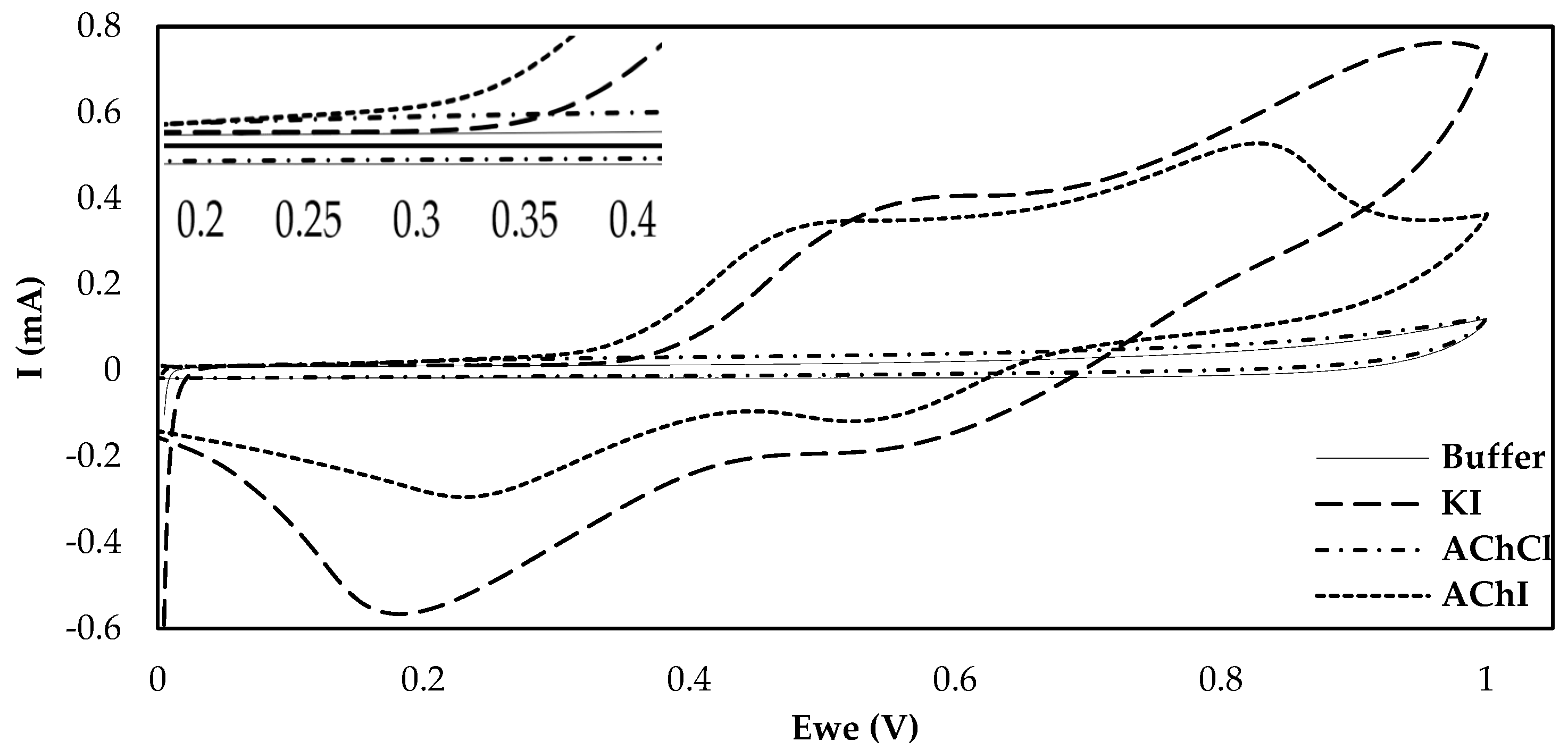
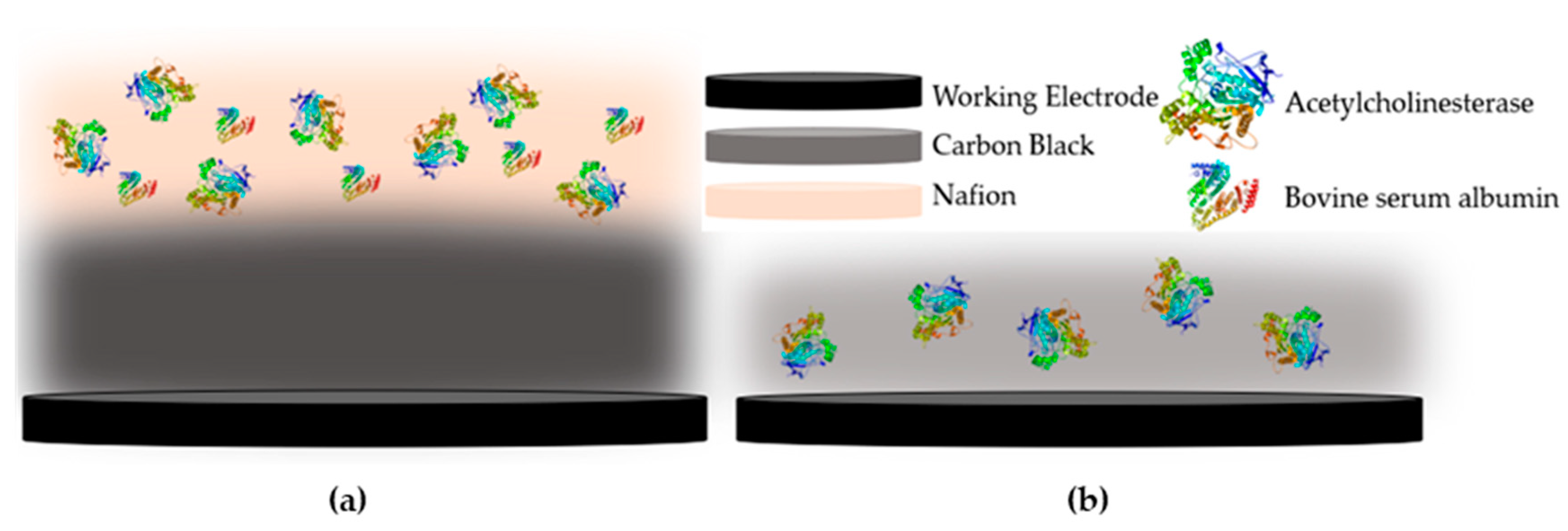
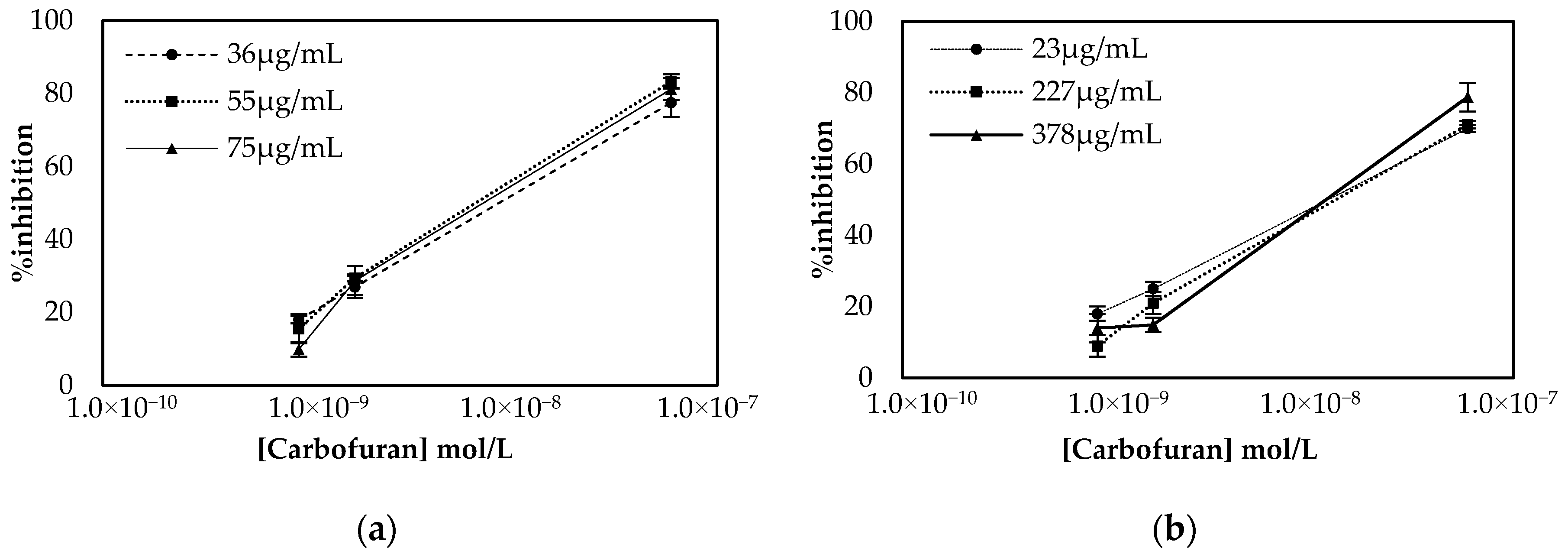
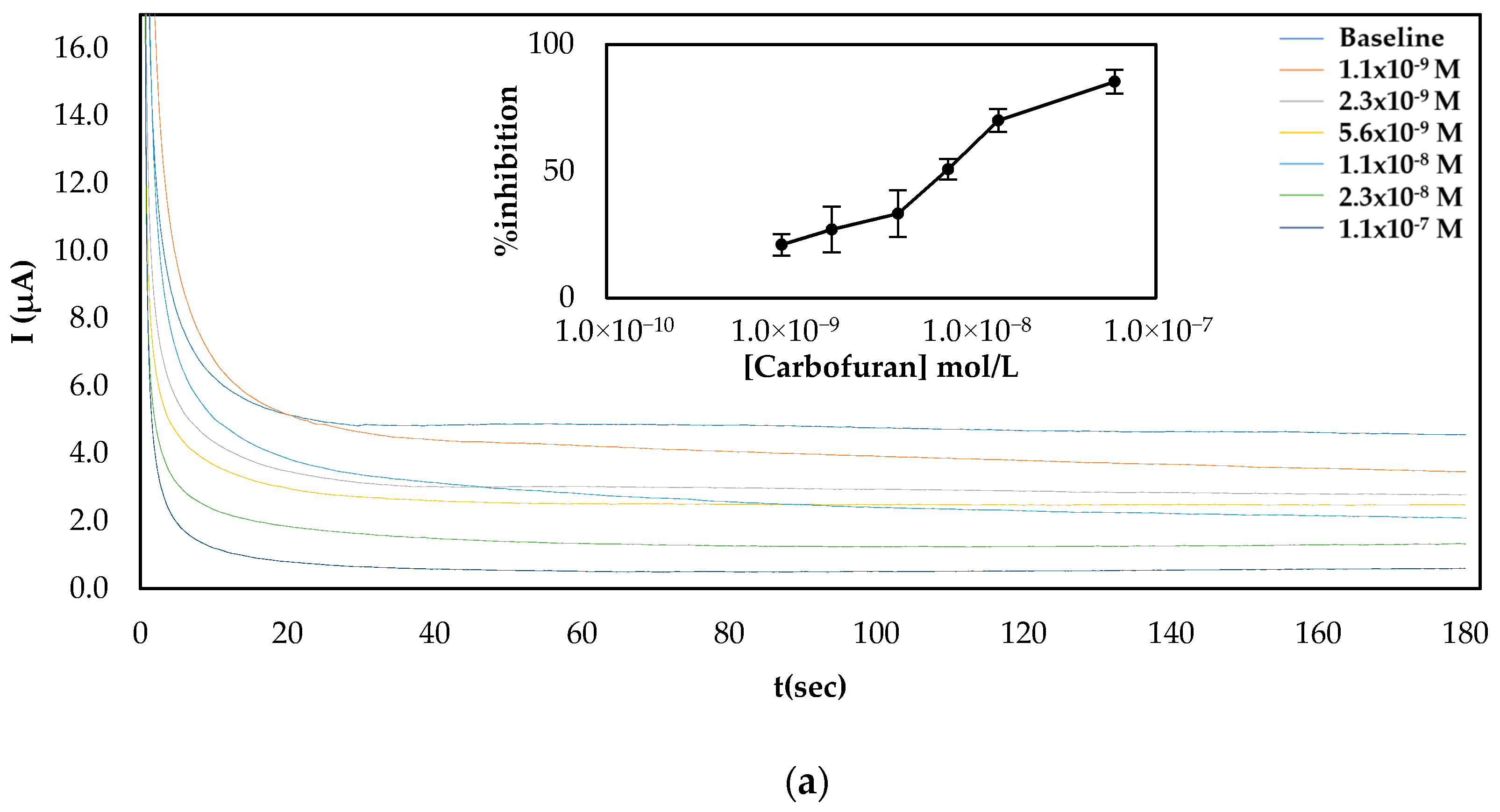
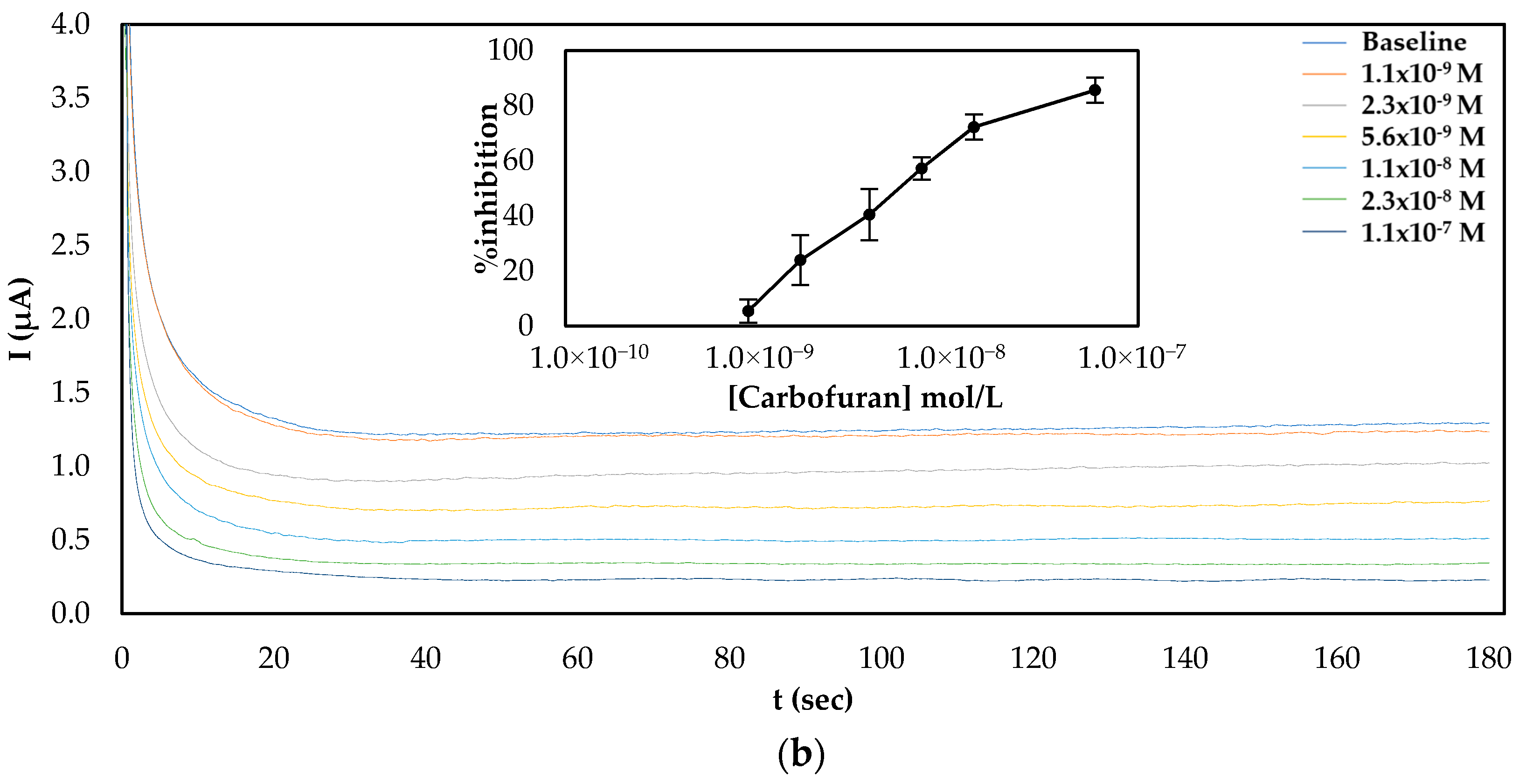
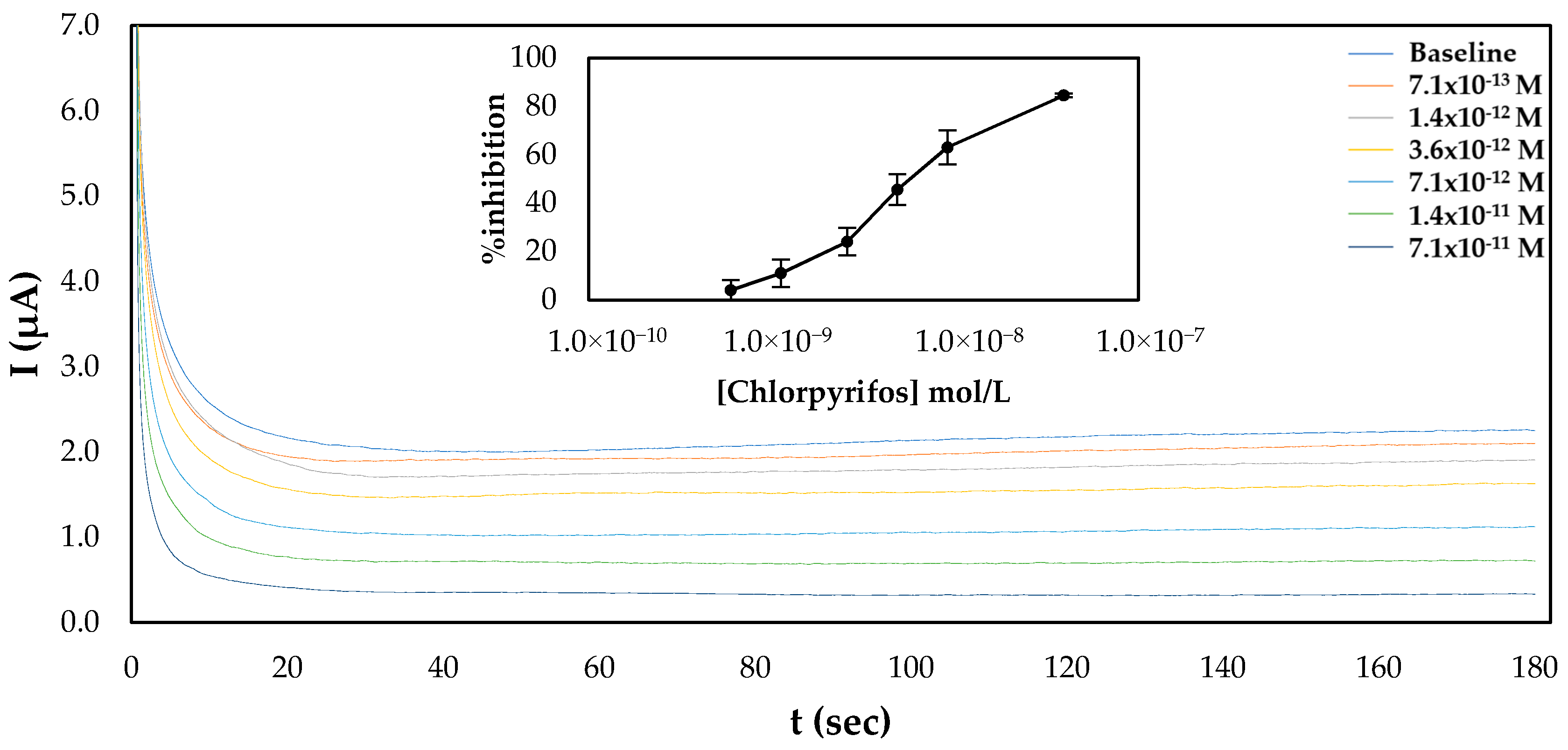
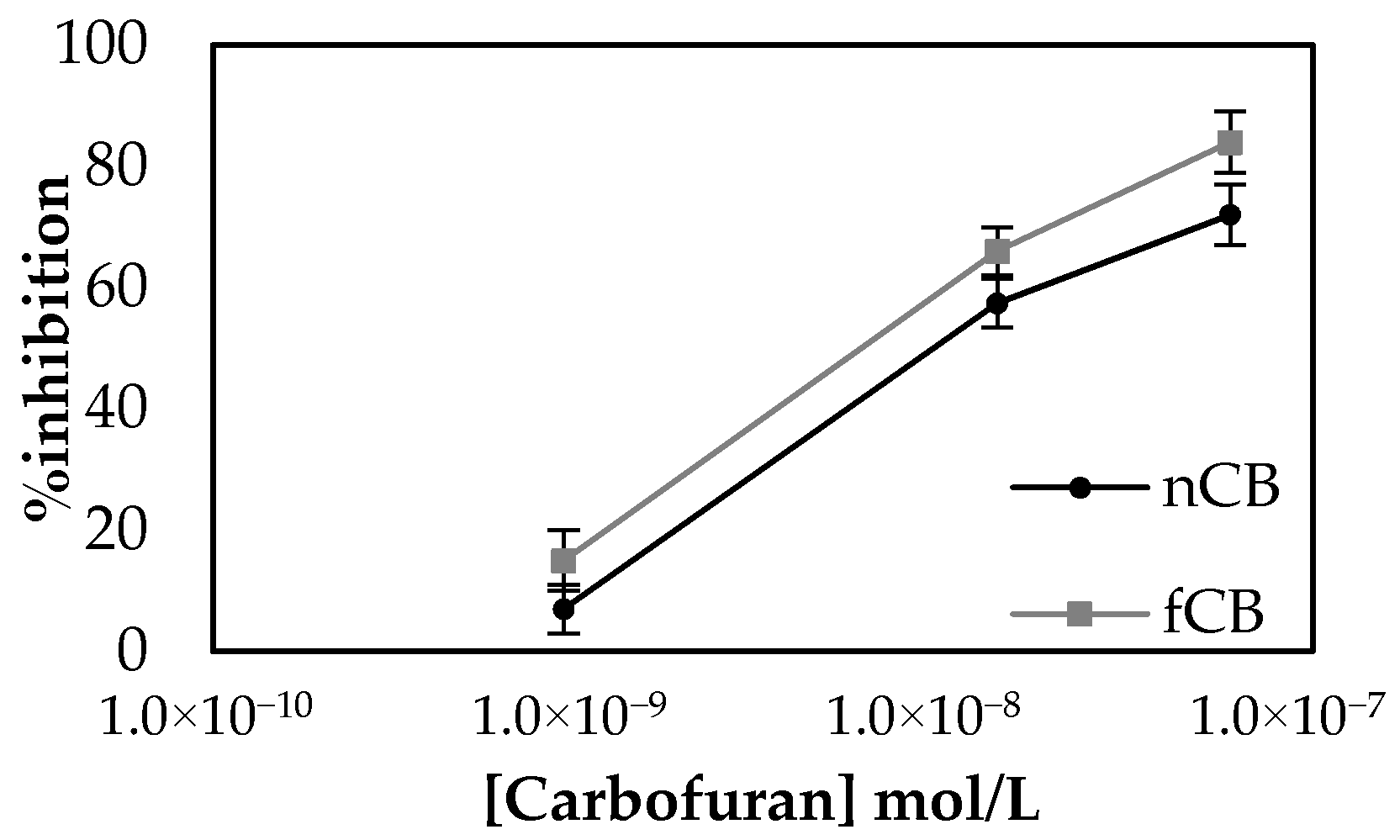
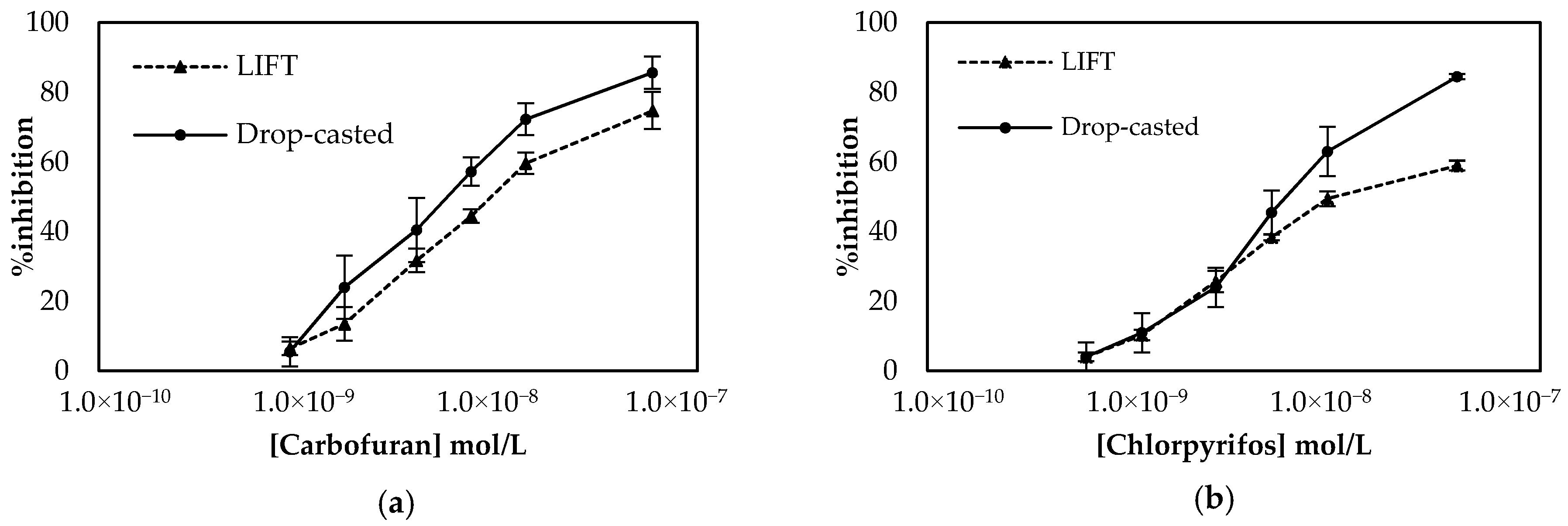
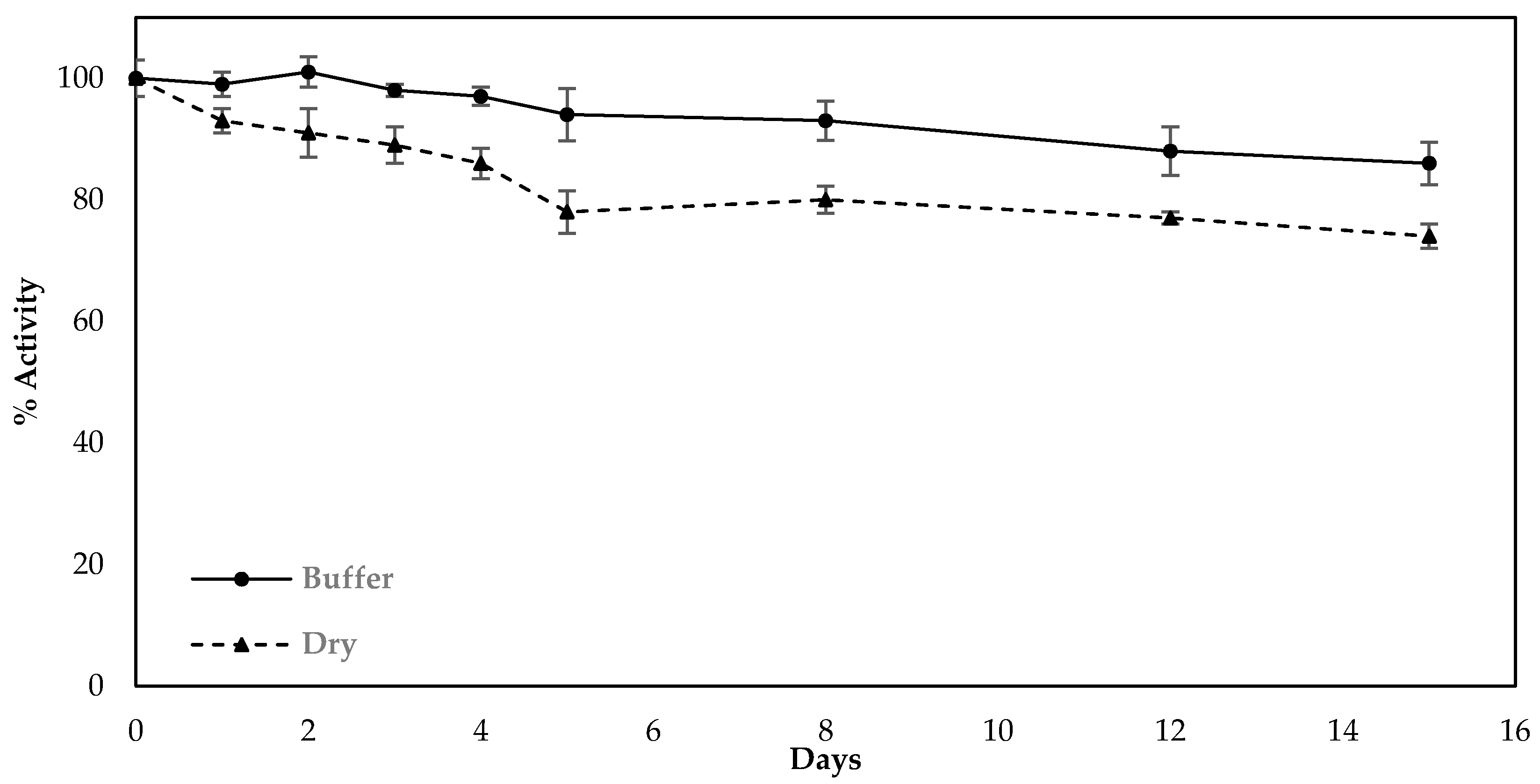
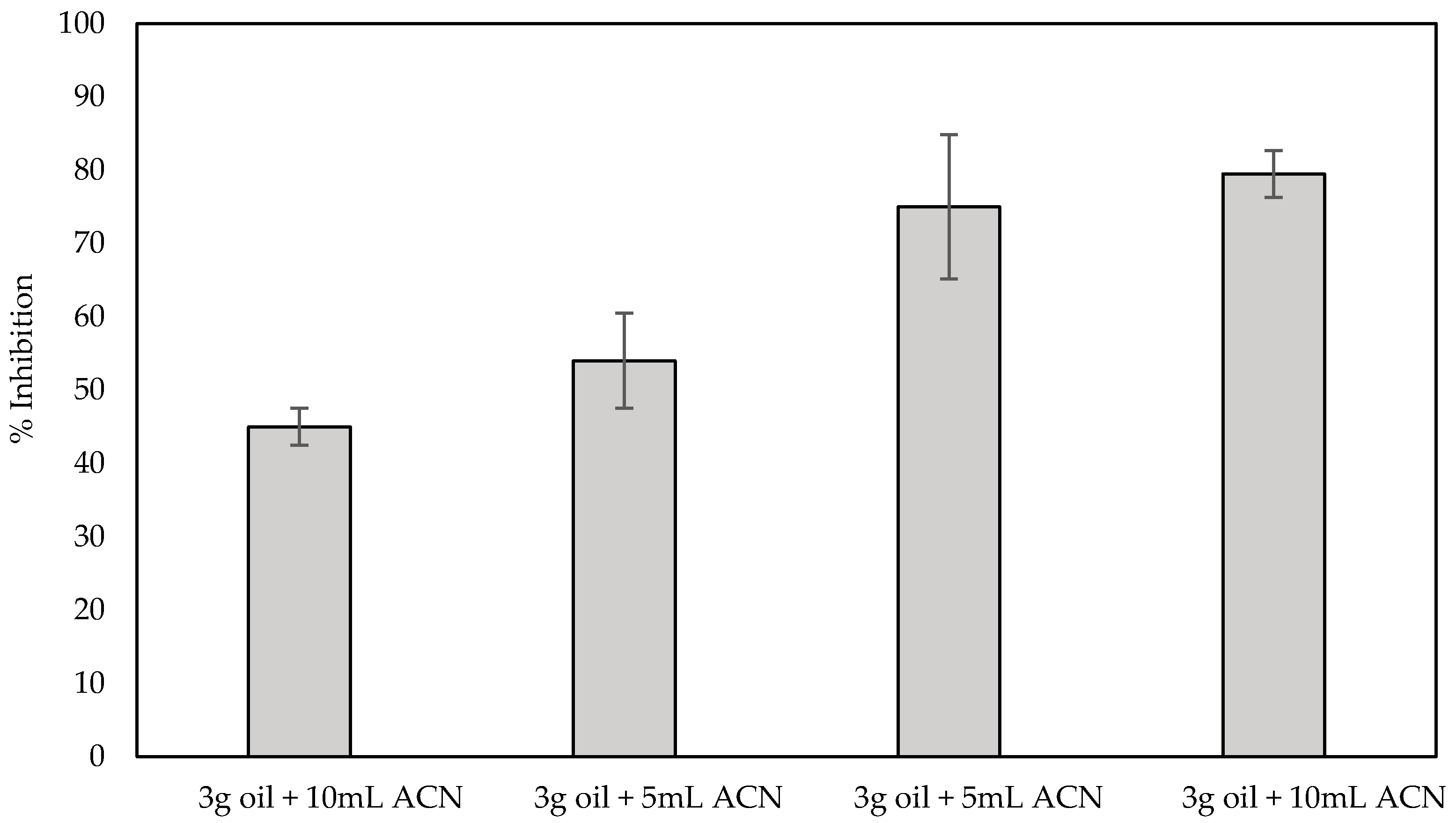
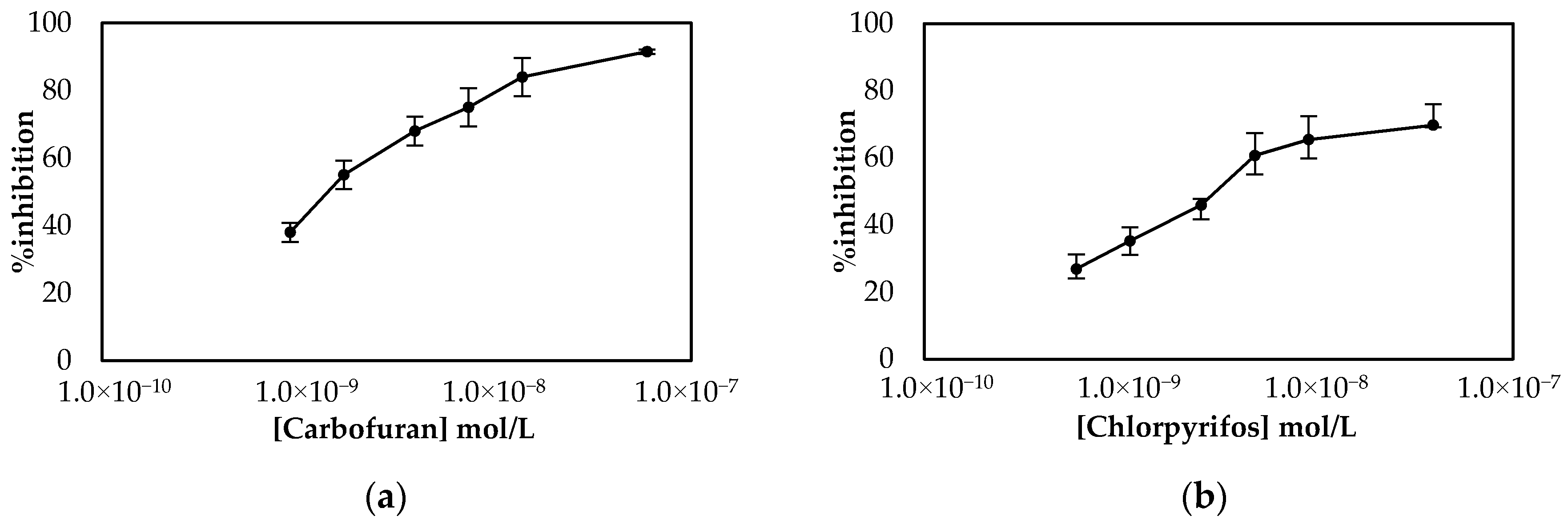
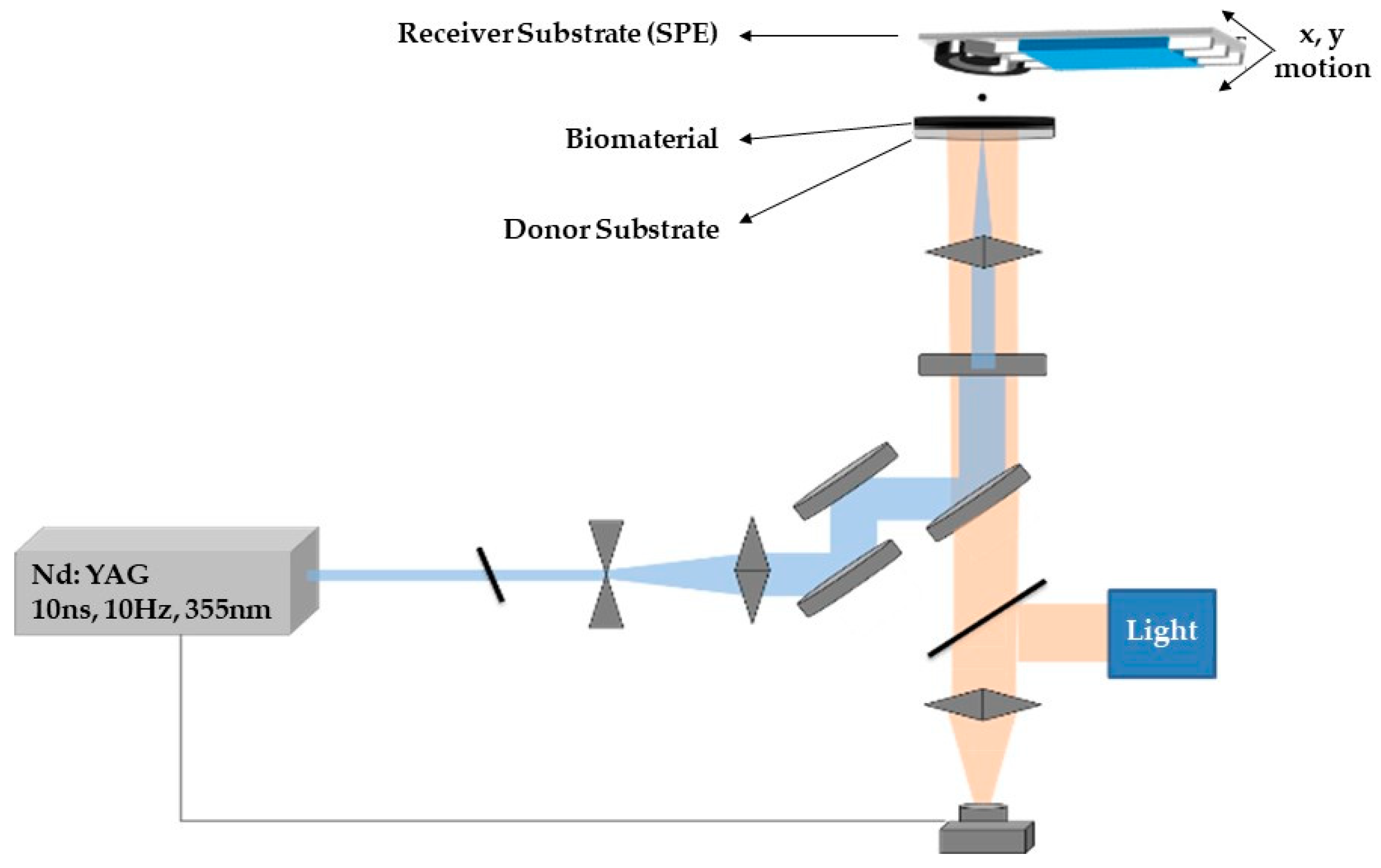
| CB Type | θC (°) | CA Error |
|---|---|---|
| fCB | 7.84 | 0.910 |
| nCB | 13.79 | 0.540 |
| Electrode Material/ Immobilization Matrix | LOD in Buffer (pΜ) | Real Samples Tested | Reference |
|---|---|---|---|
| Carbofuran | |||
| PAMAM-Au/CNTs/GCE | 4 × 103 | Onion, Lettuce, Cabbage | [55] |
| NF/CS-PB-MWCNTs-HGNs/AuE | 25 × 102 | Cabbage, Lettuce, Leek | [56] |
| NF/CS/NiONPs-CGR-NF/GCE | 0.5 | Apple, Cabbage | [57] |
| CB/AgNPs/GCE | 102 | Peanut | [58] |
| CB/Pillar[5]arene | 20 | Peanut, Beetroot | [59] |
| CB/CS | 6 × 102 | Olive Oil | This work |
| Chlorpyrifos | |||
| Fe3O4NPs/MWCNT/Au electrode | 102 | Tap Water, Milk | [60] |
| ZnS and poly(indole-5-carboxylic acid)/Au | 1.5 × 102 | Tap Water | [38] |
| PANI/CNT wrapped with ssDNA/Au | 1.0 | River Water | [37] |
| MWCNTs/SnO2/CS-SPE | 5 × 104 | Cabbage, Lettuce, Leek, Pak choi | [61] |
| MWCNTs/IL/SPE | 5 × 104 | ||
| Bromothymol blue doped sol–gel film | 11 × 104 | Water | [62] |
| ZrO2/ERGO | 0.1 | Water | [63] |
| CB/CS | 4 × 102 | Olive Oil | This work |
Sample Availability: Samples of the compounds are not available from the authors. |
Publisher’s Note: MDPI stays neutral with regard to jurisdictional claims in published maps and institutional affiliations. |
© 2020 by the authors. Licensee MDPI, Basel, Switzerland. This article is an open access article distributed under the terms and conditions of the Creative Commons Attribution (CC BY) license (http://creativecommons.org/licenses/by/4.0/).
Share and Cite
Soulis, D.; Trigazi, M.; Tsekenis, G.; Chandrinou, C.; Klinakis, A.; Zergioti, I. Facile and Low-Cost SPE Modification Towards Ultra-Sensitive Organophosphorus and Carbamate Pesticide Detection in Olive Oil. Molecules 2020, 25, 4988. https://doi.org/10.3390/molecules25214988
Soulis D, Trigazi M, Tsekenis G, Chandrinou C, Klinakis A, Zergioti I. Facile and Low-Cost SPE Modification Towards Ultra-Sensitive Organophosphorus and Carbamate Pesticide Detection in Olive Oil. Molecules. 2020; 25(21):4988. https://doi.org/10.3390/molecules25214988
Chicago/Turabian StyleSoulis, Dionysios, Marianna Trigazi, George Tsekenis, Chrysoula Chandrinou, Apostolos Klinakis, and Ioanna Zergioti. 2020. "Facile and Low-Cost SPE Modification Towards Ultra-Sensitive Organophosphorus and Carbamate Pesticide Detection in Olive Oil" Molecules 25, no. 21: 4988. https://doi.org/10.3390/molecules25214988
APA StyleSoulis, D., Trigazi, M., Tsekenis, G., Chandrinou, C., Klinakis, A., & Zergioti, I. (2020). Facile and Low-Cost SPE Modification Towards Ultra-Sensitive Organophosphorus and Carbamate Pesticide Detection in Olive Oil. Molecules, 25(21), 4988. https://doi.org/10.3390/molecules25214988









